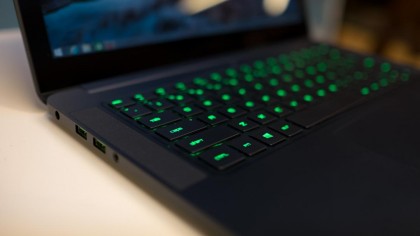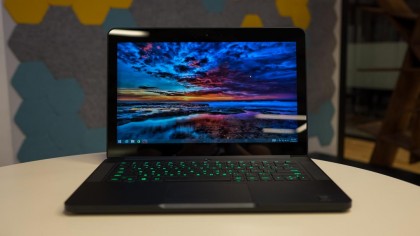Why you can trust TechRadar
The new Razer Blade doesn't just look identical to it's predecessor, it has exactly the same weight and dimensions, measuring 13.6 x 9.3 x 0.7 inches (345 x 235 x 17.9 mm) while weighing in at 4.47 pounds (2,030 g). The Blade hangs onto its throne as the world's thinnest gaming laptop, but hopeful usurpers are quickly catching up.
The Origin EVO15-S is just a tad bit thicker at 0.78 inches (19.81 mm). Despite having a wider 15.35 by 10.47 inch (389 by 265 mm) footprint and packing an additional hard drive, this 4.3 pound (1,950 g) gaming machine is lighter than the Blade. Digital Storm's Triton, meanwhile, is the biggest option in this trio, measuring 15.16 x 10.67 x 0.98 inches (385 x 271 x 24 mm) and weighing in at 5.5 pounds (2,494 g).

Here is the Razer Blade 2015 configuration given to TechRadar for this review:
Spec sheet
- CPU: 2.6GHz Intel Core i7-4720HQ (quad-core, 6MB cache, up to 3.6GHz with Turbo Boost)
- Graphics: Nvidia GeForce GTX 970M (3GB GDDR VRAM); Intel HD Graphics 4600
- RAM: 16GB DDR3L (1600MHz)
- Screen: 14-inch 3,200 x 1,800 QHD+ IGZO multi-touchscreen with LED backlight
- Storage: 256GB SSD
- Ports: 3 x USB 3.0, HDMI, headphone/mic combo jack
- Connectivity: Intel Wireless-AC 7260HMW + Bluetooth 4.0
- Camera: 2MP HD webcam
- Weight: 4.47 pounds
- Size: 13.6 x 9.3 x 0.70 inches (W x D x H)
Since we reviewed the Blade gaming laptop last year, Razer has upped the ante on this new model by packing in a faster processor and newer GPU, along with doubling the RAM. Despite these improvements, the laptop still comes priced at $2,399 (AU$3,699). The Razer Blade is not available in the United Kingdom officially, but at least two retailers on Amazon UK are selling the machine for £2,035.
No matter where you're buying it, the Blade costs a pretty penny, especially when it only comes with a 256GB SSD and doubling your storage space is another 300 smackers. For most laptops, this would be a decent chunk of flash storage to hold everything from music to gigabytes of video, but for games, you can say goodbye to all your storage space after just a few installs.

It's for these reasons - and more I'll go into shortly - that I suggest you look at the configuration with a 1,920 x 1,080 screen instead. Starting at $1,999, this full HD model comes with all the same specs as the QHD configuration, but you'll lose out on the touchscreen functionality.
In the war for the highest screen resolution, the Origin EVO15-S has the Razer Blade beat. Configuring the laptop with a 15.6-inch, 3,840 x 2,160 resolution screen bumps up the price of this unit to $2,493 (about £1,678, AU$3251). For the money, you're also getting more power under the hood, including an Nvidia GTX 970M with double the video RAM for graphics intensive games and a 1TB drive to store those said titles.
Sign up for breaking news, reviews, opinion, top tech deals, and more.
The Digital Storm Triton, meanwhile, comes with an slightly slower Intel Core i7 processor and the same GPU as the Blade for $1,620 (about £1,063, AU$1,974). Unfortunately this machine also comes with 8GB of RAM (which is still serviceable with gaming) and an even smaller 120GB SSD, though it's backed up with a 750GB HDD. Unlike the Razer or Origin machine, you'll also have a bit more leeway to upgrade the Triton's graphics to an Nvidia GTX 980M for $1,889 (about £1,246, AU$2,309).
Performance
The Razer Blade isn't just a thing of beauty with its modern looks, this 14-inch notebook also runs like a dream. Using it over the last few days, I never ran into a performance hiccup whether I was streaming 4K video on YouTube or working with some massive image files in Lightroom.
The thing I love the most about the Razer Blade? It's a QHD+ road warrior. This can be your daily driver for everyday computing and become your gaming platform at the drop of a dime (if you're near an outlet, of course).

Here's how the Razer Blade held up under the scrutiny of our benchmark tests.
Benchmarks
- 3DMark: Cloud Gate: 15,802; Sky Diver: 17,515; Fire Strike: 6,459
- Cinebench CPU: 678 points; Graphics: 103.96 fps
- PCMark 8 (Home Test): 2,856 points
- PCMark 8 Battery Life: 2 hours and 31 minutes
- Middle Earth: SoM (1080p, Ultra): 51.82 fps; (1080p, Low): 120.23 fps
- Metro: Last Light (1080p, Ultra): 28.33 fps; (1080p, Low): 97.67 fps
By going with a faster CPU, the Blade pulls ahead of the EVO15-S and the Triton with a higher Cinebench score. This processor bump in turn also helped Razer's machine perform better than its competitors with the extremely taxing 3DMark Fire Strike test. The Blade performed surprisingly worse at the PCMark8, which stresses both the CPU and GPU at the same time, likely because of the higher resolution screen.

Moving onto our gaming benchmarks, which test all machines equally at 1080p; the thin and light gaming laptop was able to play Metro: Last Light on Ultra at 97.67 fps. Unsurprisingly, this average frame rate is just a smidge higher than the Triton's 80.33 fps. Both of these scores take a backseat to the Origin, which was able to render the benchmark run with 101 fps.
Of course, synthetic benchmark tests will only tell you so much, and you're probably much more interested in the number of frames per second you can squeeze out of this QHD+ laptop. I'll say it right now, the numbers aren't good.
We have the technology but no games
While 3K gaming sounds great, you have to trade in either your high frame rate or detail level in for the increased resolution. Both Ori and the Blind Forest and Cities: Skylines ran at a stuttering 10 fps even after turning off or lowering every graphical flourish to its lowest setting. Other games, like Middle Earth: Shadow of Mordor fare much better, but you'll have to select the lowest quality settings to get anywhere near a playable 30 fps at 3,200 x 1,800 pixels.

Worse yet, some games such as Metal Gear: Ground Zeroes will simply crash attempting to start at such a high resolution. Meanwhile, the art of games that are gorgeous at 1080p, such as Dust: An Elysian Tail, suffers from being blown up.
Beyond games, the 3K resolution wrecks havoc on user interfaces. Desktop clients for both EA's Origin and Blizzard's BattleNet, as well as YouTube, all look particularly tiny on the Blade's 1,800p screen.

That said, a few older titles such as DMC: Devil May Cry and Grid Autosport still look gorgeous at the Blade's full 3,200 x 1,800 resolution (and even better: they ran at 60 fps). When it all clicks together, the higher resolution can breathe life into older games that you've long forgotten about. It's just too bad this rarely happens.
Cutting edge display
The real shame of not being able to play games at the Blade's full resolution is you won't be able to fully appreciate the beauty of the screen. The display is extremely sharp, easily translating any blocky pixels into smooth lines and curves. The panel is also extremely bright. Keeping the laptop screen at just one to two ticks above its minimum brightness was more than enough to easily use it in direct sunlight.

The real joy of using such a sharp and vibrant display is it's perfect for consuming media, especially streaming video. This excellent visual experience is also backed up by some top notch speakers, which also do a great job of projecting the sounds of gunfire and exploding magic missiles in games.
Enough juice to last a day
Unfortunately, performance isn't the only thing the more demanding QHD+ screen dings as battery life also suffer. The Blade was only able to run for 2 hours and 31 minutes running our PC Mark 8 battery test. While that's better than the Origin EVO15-S short 2 hours and 2 minute runtime, it's well behind the 3 hour and 38 minute mark that the Digital Storm Triton set.
Beyond synthetic testing, users can expect to get a maximum battery life of roughly 4 hours out of the Blade. In my own testing, I ran the machine down after 3 hours and 43 minutes with web browsing on Firefox, streaming 4K YouTube videos and playing songs over the net with Google Music. Thankfully, the dazzling display should help users stretch their power needs a bit longer, as you need to pump up the brightness more often on most other mobile rigs.

Kevin Lee was a former computing reporter at TechRadar. Kevin is now the SEO Updates Editor at IGN based in New York. He handles all of the best of tech buying guides while also dipping his hand in the entertainment and games evergreen content. Kevin has over eight years of experience in the tech and games publications with previous bylines at Polygon, PC World, and more. Outside of work, Kevin is major movie buff of cult and bad films. He also regularly plays flight & space sim and racing games. IRL he's a fan of archery, axe throwing, and board games.
